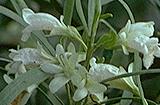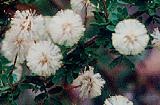|
[Front Page] [Features] [Departments] [Society Home] [Subscribe]

Sir Thomas's Plants
Betty Ballingall
Though the explorer, Sir Thomas Mitchell, is particularly remembered for his skillful survey work, the extensive botanical records he included in his journals for the country across which he travelled must be equally memorable.
In retracing his journey from St. George to Tambo (Queensland) recently, my friends and I were frequently reminded of the explorer by the plants that are named after him. We too discovered the odd and the unusual that had so intrigued Sir Thomas and were equally captivated, not only by the oddity of the plants, but also by his whimsical descriptions.
On the earliest stage of our trek, Eremophila mitchellii was one of the most common trees in the woodland communities. In fact, there was rarely a day that we did not meet with the Major's Eremophila. The shapely habit and rounded canopy of bright green leaves makes this small tree an obvious feature of the landscape. It is commonly called Sandalwood from the pleasantly aromatic foliage, particularly when put on a fire. Its neat habit and masses of white flowers make it a desirable garden plant.
 |
First discovered by Mitchell in New South Wales, Eremophila mitchellii is very widespread, extending through western NSW and central Queensland to the Gulf.
Select the thumbnail image or highlighted name for a higher resolution image (37k). Photo: Keith Townsend
|
Proceeding north, the graceful Weeping Myall, Acacia pendula, was frequently met with along the explorer's tracks, forming a picturesque landscape when scattered over the grassy black soil plains which it favours. After battling with the thickly timbered country, he was elated to come to the open myall country, which provided little hindrance to the passage of his drays. However, it raised nostalgic memories for him, as it was first collected by Allan Cunningham, whose brother, Richard, was murdered by aborigines when separated from one of Mitchell's earlier expeditions. The tree grew where they found Richard's mutilated body, and Sir Thomas quotes:
"Like a weeping mourner stooping stand,
Forever silent and forever sad."
 |
 |
| Acacia pendula (left) and Mitchell Grass plains (right): Photos Tony Rodd and Cherree Densley |
Crossing the Myall country he states, "Saw a double top hill in the centre of this fine open country and from the abundance of good pasture around it, I named it Mt. Abundance." One of the grasses in this pasture would have been a species of Astrebla, all of which are commonly called Mitchell Grass, one of the most important native pasture grasses. When Mitchell finally reached the vast Tambo plains and stood upon a rise, Mitchell Grass plains would have "extended westward beyond the reach of vision". And it still does today.
Mt. Abundance was another surprise for the explorer. When he scaled its rocky slopes he writes, "trees of a very droll forrn chiefly drew my attention here. The trunks bulged out in the middle like a barrel, to nearly twice the diameter at the ground, or of that at the first springing of the branches above. These were small in proportion to the great girth, and the whole tree looked very odd. These trees were all so alike in general form that I was convinced this was their character, and not a lusus naturae".
And so we too found them as we made camp beneath one and next morning found another on top of the mountain, possibly large enough to have seen Sir Thomas struggling up the western side. I had personally achieved my ambition to find a Bottle Tree on Mt. Abundance.
They were first named Delabechea rupestris by Lignum, but later changed to Brachychiton rupestris. Because the trees can be moved at an advanced size, they have been used extensively as street trees in country towns.
 |
 |
|
Two of the plants seen by Mitchell in Queensland were Brachychiton rupestris, the bottle tree, (left) and Erythrina vespertilio, the bat's wing coral tree (right).
Select the thumbnail image or plant names for higher resolution images (40k and 35k).
Photos: Brian Walters and Keith Townsend.
|
Following Mitchell's map northwards, we met with may of the plants mentioned in his journal, including Crotalaria mitchellii.
However, it was among the sandstone outcrops that we met with the next strange plant which he so aptly describes. "I found various very remarkable shrubs new and strange to me. One grew on a large stalk, from which leaves radiated without other or any branches. The leaves, hanging gracefully around the stem, gave to this shrub the resemblance of the plume of a staff-officer."
Indeed, it is a most unusual and striking plant that would be the envy of all if it could be introduced to gardens. There are two distinct forms which are both called Astrotricha pterocarpa because of the large panicle of winged fruit that develop after the dark purple flowers.
A revision by Tony Bean recognises two new species: Astrotricha cordata has large heart-shaped leaves with a shiny, dark green top and white woolly undersurface; A.intermedia has oblong leaves with a cream to tan coloured back. Both grow 4-6 metres high, but once they have flowered they die. However, they germinate readily so that there are always attractive young plants in the habitat.
Sir Thomas Mitchell
Major Thomas Mitchell arrived in Australia in 1827 to take up the post of Surveyor-General, a position he held for 27 years. Mitchell had training in geology and botany and was a keen observer of the land forms and vegetation of the areas where he travelled.
He explored much of eastern Australia, particularly western New South Wales and the southern and western parts of Victoria - his glowing reports of the area, which he referred to as "Australia Felix" (fortunate land), were responsible for opening up vast new grazing areas. Largely as a result of these discoveries, Mitchell was knighted in 1838.
His exploration of central Queensland, discussed in this article, took place in 1845 and comprised a party of 29 men, 23 of whom were convicts. The expedition was equipped with sufficient supplies for 12 months and was responsible for opening up the pastoral areas of central Queensland.
The route followed by Mitchell in Victoria was developed as the Mitchell Trail as a Bicentennial Project in 1988. A similar project is being implemented in Queensland as a Centenary of Federation Project.

Acacia mitchellii is named in honour of Thomas Mitchell and is common in much of the area covered by Mitchell during his exploration in south and central Victoria.
Select the thumbnail image or plant name for a higher resolution image (44k) Photo: Cherree Densley.
|
|
|
Like Mitchell, we were surprised to find the Bat's Wing Coral Tree on the grassy tabletop of Mt. Faraday. I found some of its scarlet seeds on the ground and the leafless branches had buds, for Erythrina vespertilio is one of our few deciduous trees. There were also clumps of Dodonaea. The explorer collected five new species of Dodonaea from the northern part of his journey.
Probably the gem among his discoveries is Darwinia thomasii. Because it is restricted to sandstone outcrops and mountain spurs, it has proved difficult for any attempt at cultivation, but its very attractive appearance certainly would make it a very desirable plant for garden use. An open spreading habit ensures that the dainty bell-like red flowers, with long protruding red-black styles, are well displayed. Its beauty is further enhanced by the unusual purple sheen on the small, grey-green leaves.
If, like my friends and I, Sir Thomas was able to retrace his footsteps once again, he would find many of his plants still growing in the localities at which he collected type material.
Continuing on towards Tambo, however, he would probably be elated to find hundreds of hectares of Brigalow flattened by heavy machinery, for it was when continually hampered by the dense growth of this species he wrote:
"....... and we did buffet it
With lusty sinews throwing it aside
And stemming it with jackets all in tatters."
No wonder he went into raptures when he came to fertile plains of Mitchell Grass stretching to the horizon.
|
From the December 1999 issue of the Bulletin of the Queensland Region of the Society for Growing Australian Plants. The article originally appeared in the November/December 1991 newsletter of the Toowoomba Society for Growing Australian Plants. Sadly Betty Ballingall passed away in 1998.

[Front Page] [Features] [Departments] [Society Home] [Subscribe]
Australian Plants online - December 2000
Association of Societies for Growing Australian Plants
|